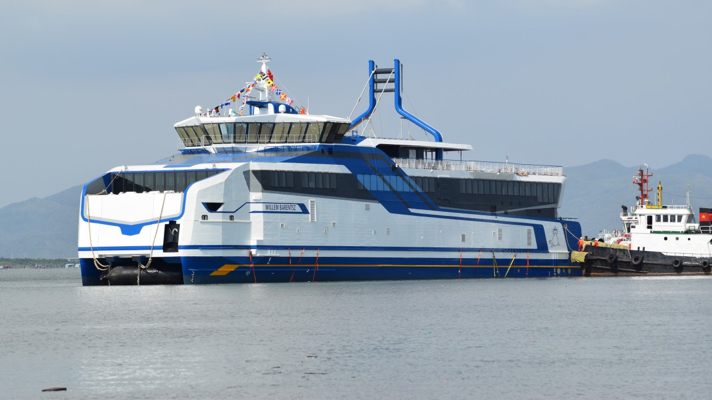After serious delays during their construction, Rederij Doeksen's two new LNG car ferries have finally arrived at Den Helder, the Netherlands. The vessels were transported by heavy lift vessel Sun Rise, which will partially submerge to unload the vessels.
The ferries Willem Barentsz and Willem de Vlamingh left Vung Tau, Vietnam, where the vessels were built on 8 March and arrived in the Netherlands on Monday evening 27 May. After an inspection by Rederij Doeksen's construction committee, the "loosening" of the ships started. For this purpose, the lashing cables and the blocks with which the ships were secured and which are welded to the deck of the Sun Rise are unfastened.
Early this morning, a start was made filling up the Sun Rise's ballast tanks, so that the ship partially sinks. First one of two Platform Supply Vessels on board will be unloaded to clear some space after which the LNG catamarans will be unloaded. It is expected this will take place around 9.00 a.m., after which the journey to Nesta Shipping in Harlingen will begin for final outfitting.
Seven Tugboats
Seven tugboats will be used for this tugging job. Each of the LNG (Liquefied Natural Gas) powered ships is towed by one tug, while at the rear they are kept "on course" by two smaller tugboats. The seventh tug is a "reserve boat" for general assistance. The LNG ships themselves are not yet able to sail. The route goes via the Texelstroom, the Doove Balg and the Boontjes to Harlingen. If everything goes according to plan, the new catamarans arrive in Harlingen between 6.00 and 7.00 pm.
Technological First
Technologically, these ships are a first. They are the very first single fuel LNG ferries in the Netherlands and the very first ships in the world in which single fuel LNG engines directly drive a fixed propeller. From 7 January 2020, the ships will be used structurally in the timetable on the Terschelling and Vlieland lines.
Project Suffers Many Delays
In 2016, Rederij Doeksen commissioned the Australian company Strategic Marine to build two new catamarans to be powered by LNG. The vessels will operate on the Wadden Sea on the lines Terschelling and Vlieland. Design agency Vripack from Sneek was responsible for the design of the interior and exterior.
The project has been plagued by delays since the contract was signed. The vessels were originally scheduled for delivery at the end of 2017. After the shipyard's Australian holding company Triyards faced financial difficulties, construction kept on being delayed. Rederij Doeksen finally decided to take matters into its own hands and transported the vessels to the Netherlands to finish them there.
Wadden Fund
The new ships are equipped with innovative applications that make the ships much more energy efficient and substantially cleaner than conventional ferries. The project actively contributes to the theme 'Sustainable development of ports and energy transition' from the Pioneer Programme Wadden Fund 2012-2013. The Wadden Fund granted Rederij Doeksen a subsidy of € 1,207,500 for this new construction project.
Picture: The Willem Barentsz shortly after its launch (from "Maand Maritiem", SWZ|Maritime February 2019).
Related News
- Further Delays for Doeksen's New LNG Ferries
- VIDEO: Doeksen's New Ferries Launched
- Doeksen Orders LNG from Titan LNG for Its New Ferries








